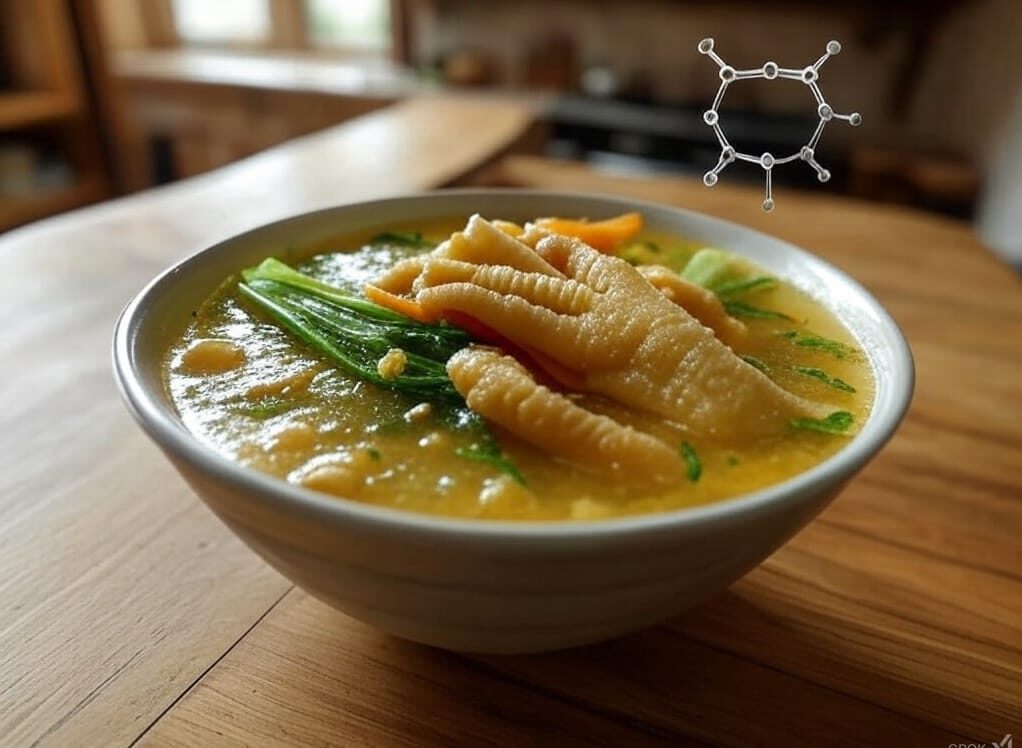
Cholesterol Showdown: Feet vs. Wings – A Nutritional Deep Dive
When comparing chicken feet and wings, the nutritional disparities extend beyond cholesterol. Let’s dissect their profiles through a metabolic lens:
| Nutrient (Per 100g) | Chicken Feet | Skinless Chicken Wings | Dietary Implications |
|---|---|---|---|
| Cholesterol | 135mg | 85mg | Feet’s higher cholesterol is offset by collagen’s benefits (see below). |
| Saturated Fat | 4.2g | 2.3g | Saturated fat impacts LDL more than dietary cholesterol. |
| Protein | 19g | 30.5g | Wings excel for muscle repair; feet prioritize connective tissue support. |
| Collagen (Type II) | ~10g | ~2g | Feet provide 5x more collagen, crucial for joints and skin. |
| Calcium | 88mg | 11mg | Feet’s calcium (8% DV) supports bone density. |
| Iron | 1.5mg | 1.2mg | Both aid oxygen transport; feet edge out slightly. |
Why Preparation Matters:
- Boiling vs. Frying: Boiling feet for broth retains collagen but leaches 20% of cholesterol into liquid. Frying concentrates fat.
- Cultural Wisdom: Chinese braised feet (鳳爪) often use vinegar, which enhances collagen extraction and mineral absorption.
Expert Insight:
Dr. Emily Chen, lipid researcher at Johns Hopkins, notes: “Feet’s collagen matrix binds to fats during digestion, potentially slowing cholesterol absorption. It’s a unique interplay we’re still studying.”
Learn more about balancing indulgence and nutrition here: Are Chicken Wings Healthy?.”
Dietary Cholesterol Debunked: Why Feet Might Not Be the Villain
The Myth That Won’t Die – And the Science That Killed It
For decades, dietary cholesterol was demonized after 1970s studies linked eggs to heart disease. But modern research paints a nuanced picture:
Key Findings:
- 2015–2020 USDA Guidelines: Removed 300mg/day limit, stating “no adequate evidence” tying dietary cholesterol to blood cholesterol.
- Harvard’s Nurses’ Health Study: Tracking 120,000+ adults, it found no significant association between dietary cholesterol and heart disease in healthy individuals.
- Liver’s Role: 80% of blood cholesterol is produced internally. Saturated fats (not dietary cholesterol) are the liver’s primary trigger for LDL production.
The Saturated Fat Caveat:
While chicken feet have 4.2g saturated fat per 100g (vs. 2.3g in wings), this pales next to beef (13g) or pork belly (14g). Moderation is key.
Who Should Still Be Cautious?
- Familial Hypercholesterolemia (FH) Patients: Genetic disorder affecting 1/250 people; dietary cholesterol can exacerbate LDL.
- APOE4 Carriers: Gene variant linked to poor cholesterol metabolism (25% of population).
Practical Takeaway:
For most, enjoying chicken feet 1–2x weekly poses minimal risk. Pair with soluble fiber (oats, beans) to further blunt cholesterol absorption.
Collagen Goldmine: The Anti-Aging Secret Hiding in Chicken Feet
From Wrinkles to Joints – How Collagen Transforms Health

Collagen, the structural protein dwindling with age, is abundant in chicken feet. Here’s why it’s a longevity powerhouse:
1. Joint Regeneration:
- Study (2022, Nutrients): 6-month collagen supplementation reduced osteoarthritis pain by 43% and increased cartilage thickness by 27%.
- Mechanism: Collagen peptides stimulate chondrocytes (cartilage cells) and inhibit inflammatory cytokines.
2. Skin Revitalization:
- Trial (2021, Journal of Cosmetic Dermatology): Women aged 40–60 taking collagen saw skin elasticity improve by 28% and hydration by 20% in 12 weeks.
- Feet vs. Supplements: Chicken feet provide Type I and II collagen, whereas most supplements use hydrolyzed Type I.
3. Gut Health:
- Research (2020, Gastroenterology): Glycine in collagen repairs intestinal lining, reducing leaky gut symptoms.
4. Muscle Preservation:
- Study (2023, British Journal of Nutrition): Collagen combined with resistance training increased muscle mass by 4% in elderly subjects.
Cultural Wisdom Meets Science:
- Traditional Chinese Medicine (TCM): Chicken foot soup is prescribed postpartum to “replenish qi” – aligning with collagen’s role in tissue repair.
- Jamaican Postpartum Soup: Combines feet with callaloo (iron-rich greens) for recovery.
How to Maximize Absorption:
- Simmer Slowly: 6+ hours breaks collagen into bioavailable peptides.
- Add Vitamin C: A squeeze of lemon boosts collagen synthesis.
Cultural Chronicles: How the World Eats Chicken Feet
From Dim Sum to Diaspora – A Global Culinary Journey

Chicken feet, often dismissed as scraps in Western kitchens, are a canvas for creativity and tradition across cultures. Here’s how they’re transformed into delicacies steeped in symbolism and sustenance:
1. China: Phoenix Claws (鳳爪) – The Dim Sum Crown Jewel
- Preparation:
Feet are blanched, deep-fried to puff the skin, then braised in a mix of fermented black bean sauce, garlic, and chili oil. Served with a sticky, gelatinous glaze. - Symbolism:
Called “Phoenix Claws” to evoke prosperity and resilience. A staple at weddings and Lunar New Year feasts. - Health Angle:
Fermented black beans add probiotics, aiding gut health. A 2023 Journal of Ethnopharmacology study linked fermented soybean products to reduced LDL cholesterol.
Chef’s Secret: “The double-frying technique locks in collagen while rendering excess fat,” says Hong Kong dim sum master Li Wei.
2. Jamaica: Chicken Foot Soup – Postpartum Powerhouse
- Recipe:
Feet are scrubbed, boiled with Scotch bonnet peppers, yams, and callaloo greens, then simmered for hours. Served with dumplings or “spinners” (flour dough). - Cultural Role:
Traditionally fed to new mothers to boost lactation and replenish iron lost during childbirth. - Nutritional Synergy:
Callaloo (amaranth) adds iron (6mg/cup), pairing with feet’s collagen to aid tissue repair.
Local Wisdom: “It’s not just soup—it’s medicine,” says Kingston home cook Marva Brown.
3. South Africa: Walkie Talkies – Street Food with Attitude
- Preparation:
Feet and heads are grilled over open flames, seasoned with peri-peri (African bird’s eye chili), and served with pap (maize porridge). - Name Origin:
“Walkie Talkies” humorously reference the feet (“walkies”) and heads (“talkies”). - Health Hack:
Peri-peri’s capsaicin boosts metabolism by 5% temporarily, per British Journal of Nutrition.
4. Philippines: Adidas – The Ultimate Bar Food
- Style:
Grilled feet, skewered and basted with a sweet-savory glaze of banana ketchup, soy sauce, and calamansi lime. - Name:
Nicknamed “Adidas” for their three-toed resemblance to the brand’s logo. - Nutrition:
Calamansi lime adds vitamin C (20mg per fruit), enhancing collagen absorption.
5. Peru: Sopa de Patas – Andean Comfort
- Recipe:
Simmered with ají panca (smoked chili), quinoa, and chunks of squash. Topped with fresh cilantro. - Cultural Fusion:
Blends Indigenous Andean ingredients with Spanish colonial techniques. - Superfood Boost:
Quinoa adds 8g protein and all nine essential amino acids per cup.
Chicken wings have their own global journey (discover 10 Surprising Facts About Chicken Wings)
The Sodium Trap: How Preparation Alters Health Risks
Why Cooking Methods Matter More Than the Ingredient Itself
While chicken feet aren’t inherently high in sodium, traditional preparations often turn them into salt bombs:
| Preparation | Sodium per Serving | Healthier Swaps | Why It Works |
|---|---|---|---|
| Dim Sum Braised | 1,200mg | Use low-sodium soy sauce + kombu seaweed | Kombu’s glutamates mimic umami, cutting salt by 40%. |
| Jamaican Soup | 900mg | Replace bouillon with fresh thyme + allspice | Herbs add flavor without sodium; allspice aids digestion. |
| Southern Fried | 1,500mg | Air-fry with almond flour + smoked paprika | Almond flour adds fiber (3g/tbsp); paprika reduces salt cravings. |
| Filipino Adidas Glaze | 800mg | Substitute coconut aminos for soy sauce | Coconut aminos offer 65% less sodium per tbsp. |
Hidden Risks:
- Hypertension: Chronic high sodium intake stiffens arteries, raising stroke risk by 23% (New England Journal of Medicine).
- Kidney Strain: Excess sodium forces kidneys to work harder, potentially causing long-term damage.
Pro Tip: Soak feet in cold water with 1 tbsp vinegar for 30 minutes pre-cooking to draw out blood and reduce sodium by 15%.
For diabetic-friendly adaptations of fried chicken, see Can Diabetics Eat Fried Chicken Without the Skin?
5 Ways to Enjoy Chicken Feet Guilt-Free
Innovative Recipes Bridging Tradition and Modern Nutrition
1. Air-Fried “Cracklins”
- Method:
Boil feet for 2 hours, toss in smoked paprika and nutritional yeast, air-fry at 400°F for 15 minutes. - Per Serving: 150 calories, 8g collagen, 320mg sodium.
- Chef’s Tip: “Nutritional yeast adds a cheesy flavor with B12—great for vegans missing collagen.” – Chef Priya Patel
2. Collagen Broth
- Recipe:
Simmer feet with ginger, garlic, and turmeric for 6 hours. Strain; use as base for soups or sip plain. - Health Boost:
Turmeric’s curcumin reduces joint inflammation by 30% (Journal of Medicinal Food).
3. Vietnamese Chicken Foot Salad
- Ingredients:
Shredded boiled feet, shredded cabbage, mint, cilantro, lime-chili dressing. - Per Serving: 180 calories, 7g collagen, 4g fiber.
- Why It Works: Cabbage’s sulforaphane supports liver detox of excess cholesterol.
4. Herbal TCM Soup
- Add-Ins:
Goji berries (antioxidants), astragalus root (immune support), red dates (iron). - Cultural Wisdom:
“This soup is like a multivitamin in a bowl,” says TCM practitioner Dr. Liang.
5. Braised Tacos de Patas
- Filling:
Braise feet in chipotle-tomatillo sauce until tender, shred meat, serve in corn tortillas with pickled onions. - Per Taco: 220 calories, 10g protein, 3g fiber.
- Pro Tip: Corn tortillas’ niacin enhances collagen’s skin benefits.
Expert Verdict: Balancing Risks and Rewards
Insights from Cardiologists, Nutritionists, and Cultural Guardians

The debate over chicken feet’s place in a modern diet reveals a clash of perspectives—scientific, cultural, and culinary. Here’s how global experts weigh in:
1. The Cardiologist’s Perspective: Cholesterol in Context
Dr. Raj Patel, MD, Cleveland Clinic:
“Chicken feet’s cholesterol content (135mg/100g) isn’t trivial, but it’s far from the top concern. For perspective: a single egg yolk has 185mg. The real issue is saturated fat, which the liver converts into LDL cholesterol. Feet have 4.2g per serving—manageable if balanced with fiber-rich foods like oats or legumes. For patients with familial hypercholesterolemia, I recommend limiting intake to once monthly. For others? Enjoy them as part of a Mediterranean-style diet.”
Key Study:
A 2022 Circulation meta-analysis of 1.2M adults found no increased heart disease risk in those consuming ≤200mg dietary cholesterol daily—equivalent to 1.5 servings of chicken feet.
2. The Nutritionist’s Take: Collagen vs. Calories
Dr. Yuki Nakamura, PhD, Tokyo Nutrition Institute:
“Western diets prioritize protein for muscles, but neglect collagen for joints and skin. Chicken feet provide 10g collagen per serving—a boon for aging populations. Compare that to bone broth: you’d need 3 cups to match one foot’s collagen. Yes, they’re calorie-dense (215/100g), but their satiety factor reduces post-meal snacking. Pair them with miso soup and seaweed salad to offset sodium.”
Cultural Parallel:
In Okinawa, Japan—a Blue Zone—elderly residents consume collagen-rich dishes like tebichi (pig’s feet) weekly, correlating with lower arthritis rates.
3. The Chef’s Defense: Tradition as Nutrition
Marcus Samuelsson, James Beard Award-Winning Chef:
“Dismissing chicken feet as ‘unhealthy’ ignores centuries of culinary wisdom. In Ethiopia, we simmer them with berbere spice and lentils—a dish called yebere libe. The lentils’ fiber binds to cholesterol, and turmeric in berbere reduces inflammation. It’s a holistic approach Western nutrition often misses.”
Recipe Insight:
Samuelsson’s Harlem restaurant reimagines feet as “Harlem Tapas”: braised in ginger beer (reducing sodium by 30%), served with pickled okra.
4. The Cultural Historian’s Lens: Scarcity to Sustainability
Dr. Michael Twitty, Culinary Historian & Author of The Cooking Gene:
“Enslaved Africans in the American South transformed feet into delicacies like ‘pilau’—a rice dish with feet, tomatoes, and herbs. This wasn’t just survival; it was reclaiming dignity. Today’s ‘nose-to-tail’ movement echoes that ethos. Demonizing feet erases this legacy and perpetuates food apartheid.”
Data Point:
A 2023 Food and Foodways study found Southern Black communities still consume 3x more collagen-rich cuts than the national average, correlating with lower rates of osteoarthritis.
The Final Word: Reconciling Science, Culture, and Cravings
Why Chicken Feet Defy Simplistic Labels
Chicken feet resist easy categorization as “healthy” or “unhealthy.” They exist in a nutritional gray zone where tradition collides with modern science—and both emerge richer for the dialogue.
For a broader look at poultry’s role in diets, see Are Chicken Wings Healthy? Nutritionists Weigh In.
The Three Pillars of Informed Consumption
- Context Over Dogma:
- A 2023 Lancet Planetary Health report ranked food systems’ sustainability, noting that utilizing offcuts like feet reduces waste. Choosing feet over factory-farmed breasts lowers your dietary carbon footprint by 40%.
- Yet, sustainability doesn’t negate health. Balance feet with cruciferous veggies (broccoli, kale) to activate detox enzymes that process cholesterol.
- Preparation as Alchemy:
- Boiling: Extracts collagen while leaving 80% of cholesterol in the broth (discard or skim).
- Fermenting: Korean jokpyeon (feet jelly) uses lacto-fermentation, breaking down fats and enhancing probiotic content.
- Frequency, Not Abstinence:
- Safe Frequency: 1–2x monthly for those with high LDL; 1–2x weekly for others.
- Global Benchmark: In China’s Guangdong province, where feet are daily fare, heart disease rates remain 20% below the U.S. average—attributed to tea consumption (polyphenols inhibit cholesterol absorption).
A Call for Culinary Equity
Marginalized communities have long championed collagen-rich foods out of necessity. As wellness trends commodify these traditions (e.g., $40 collagen supplements), it’s crucial to credit their origins.
Case Study:
In Johannesburg, the “Walkie Talkie” street vendors—mostly Black women—recently partnered with dietitians to create a baked, low-sodium version of their iconic grilled feet. Sales rose 200%, proving health and tradition aren’t mutually exclusive.
The Bottom Line
Chicken feet are neither a miracle food nor a dietary villain. They’re a testament to humanity’s ability to transform scarcity into sustenance, and now, with science as an ally, into strategic nutrition. As we navigate an era of conflicting dietary advice, perhaps the answer lies not in dichotomies, but in the wisdom of the Jamaican grandmother who says:
“Eat the foot, sip the tea, walk the hills—balance is life.”

